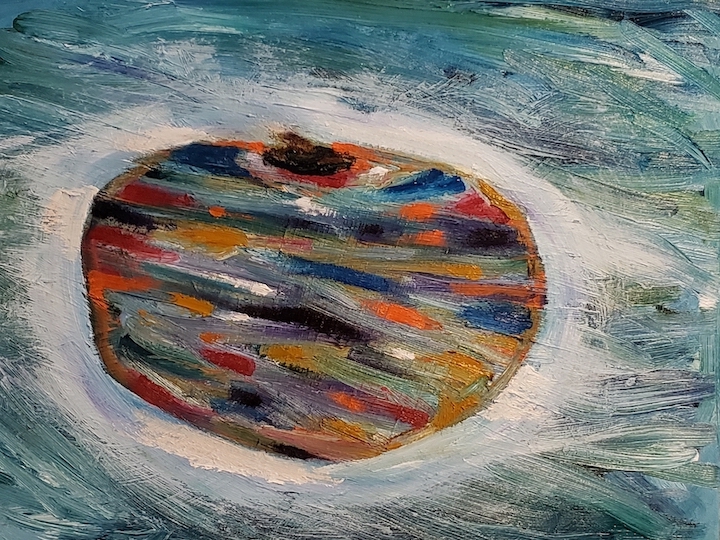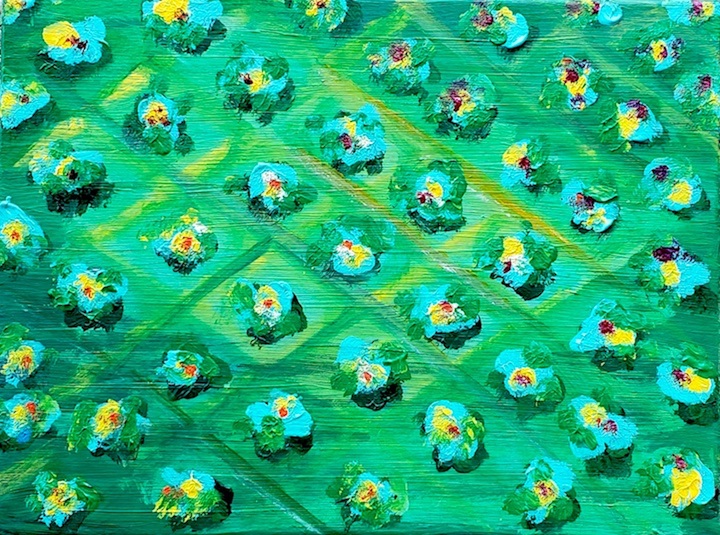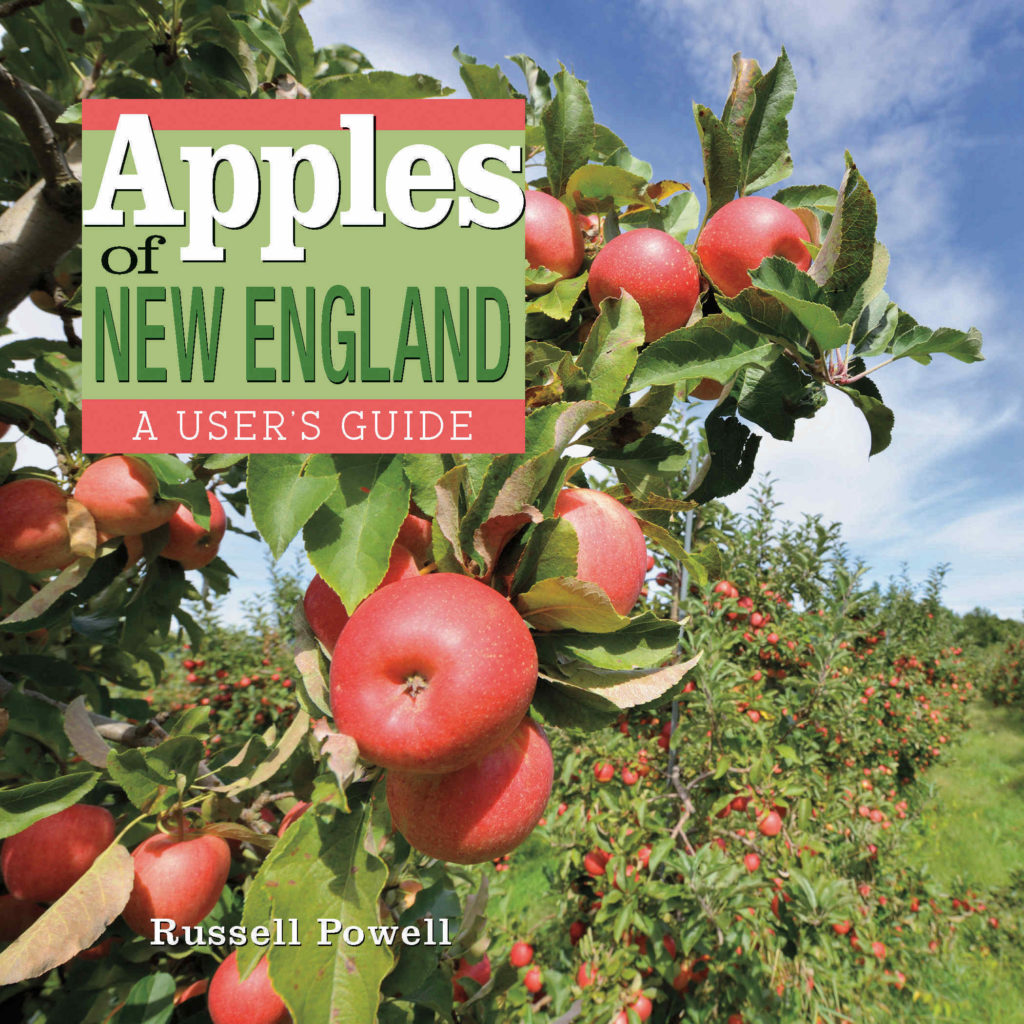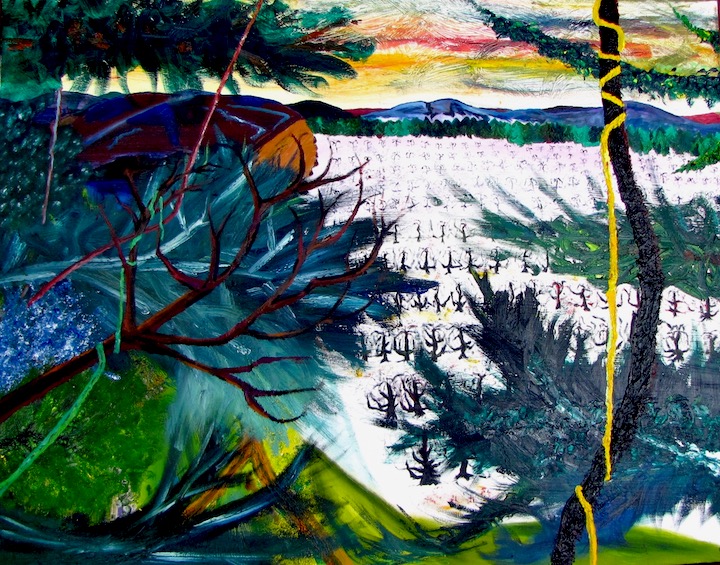ORCHARD OVERLOOK, oil on canvas, 48×60
GIVEN MY FAMILY HISTORY, it seems perfectly natural that I might end up spending years writing about (and painting) apples and agriculture.
Yet I knew little of that history when I started down the orchard path nearly 30 years ago. I stumbled into the world of apples, in fact, while looking for work after I was unceremoniously laid off from my job at a community college. I had no idea that it would last, much less become a lifelong passion.

This much I knew:
MY MATERNAL AND PATERNAL GRANDPARENTS operated apple orchards in the central Massachusetts town of Brookfield, where I grew up.
Alger and Elsie Powell bought a homestead on Rice Corner Road in 1916, and they ran a successful orchard there until 1955 (ironically the year I was born).
There were about 25 acres of trees, and most of the crop was trucked to a wholesale market in Springfield.
When Alger was ready to retire, my father, John — the youngest of Alger’s and Elsie’s four sons, and the only one to return to the homestead — decided that the life of growing apples was not for him, and he closed the farm, uprooting the trees and reverting orchard to field.
The cement-floored apple barn built into a hillside was converted into an upholstery shop, and furniture rather than boxes of apples were loaded in and out of the old Plymouth truck.
The orange, wide-wheeled Allis Chalmers tractor was reduced to hauling brush and plowing our driveway in winter, rather than carrying bins of apples from field to barn. Wooden apple ladders and other tools of the apple-growing trade were scattered throughout the barn.

Those, and a few isolated apple, pear, and plum trees were the only remnants of the orchard as I grew up. No longer cared for, the apple trees were ideal for climbing, but the fruit was gnarly and sour, better for practicing my aim against a stonewall than for eating.
MY MATERNAL GRANDFATHER, Lee Boyce, was manager of Elm Hill Farm (his wife Beatrice died soon after I was born).
A much larger operation than the Powell farm, Elm Hill had Morgan horses and Jersey cows in addition to apples (Elm Hill was the home of the original Elsie the Cow, the bovine face behind the Borden dairy company’s famous logo).
I fondly remember visiting the orchard as a child, snacking on crisp Cortland and McIntosh and breathing the perfume of apples in the Elm Hill packinghouse. The accompanying sounds made a comforting cacophony: conversations competing with the clatter of conveyors, tractors moving bins, trucks being loaded.
My older cousins, aunts, and uncles worked side by side with the farm’s other employees cleaning, grading, and wrapping each apple in tissue paper before packing it quickly but gently into a cardboard box. My job, in my mother’s words, was simply “to stay out from under foot.”
Those childhood memories were the extent of my interest in apples for many years. I left Brookfield, first for college and then where my family and career took me. I became a journalist, and a marketing specialist for higher education until 1996, when a colleague, Christine Copeland, invited me to join forces on a proposal to manage the nonprofit New England Apple Association.
Eventually she moved on and I became executive director, and I have been writing about and photographing apples ever since.
* * *

IT IS HARD TO IMAGINE that something as specialized as not just apples, but promoting apples, could be in one’s blood. Yet just over a decade ago I discovered deep ancestral roots behind my meandering path to this beguiling fruit.
I knew that my grandfather Alger came to Brookfield from Ghent, New York, and that my great-grandfather, George Townsend Powell, owned an apple orchard there.
But it was only when I came across some yellowed newspaper clippings while researching my first book that I learned of striking similarities between my career and previous generations.
It was only then that I learned that George Powell, in addition to owning Orchard Farm, was one of the founders of the Horticultural Society of New York and served as its president from 1910 to 1914.
It was not until 2014, after I had published Apples of New England, that I discovered to my astonishment that George Powell also wrote a book about apples (The Apple: The King of Fruits), more than a century before mine!
George Powell’s slim volume was written for horticulturalists, mine for the general population. But we both include descriptions of old New England varieties like Baldwin (1741), Northern Spy (1840), Rhode Island Greening (1600s), and Roxbury Russet, America’s first named variety (1635).
Great-grandfather George had three sons who went on to careers in agriculture (Alger, the youngest, was the only one to grow apples).
Edwin, the eldest, spent his career writing about agriculture. He authored or co-authored books on such diverse topics as Making Poultry Pay, Street and Shade Trees, and Barn Plans and Outbuildings, and later went to work for the United States Department of Agriculture’s (USDA) division of publications, where he eventually retired as chief editor.
Prior to the USDA, he served for years as editor of the newspaper Farm and Home in Springfield, Massachusetts — less than 25 miles from where I have lived for most of my adult life. The publication featured “fiction, poetry, special articles, and technical or practical articles on farming and household affairs,” according to The Writer’s Directory of Periodicals.
My magazine, New England Watershed: A Journal of Art, Culture, and Ideas, which I published from 2005 to 2007, regularly featured poetry and devoted one of its nine issues to food and farming.
Edwin was a great gardener in his own right, but of flowers, not apples; at the time of his death in 1953, nearly 50 of his narcissus hybridizations were registered with the Royal Horticultural Society in London.
I share a love of gardening, if not the distinction. I have planted hundreds of flowering bulbs in my yard, and my book, Living Without Lawn: Rethinking the Front Yard, describes a five-year project to convert much of my yard to from lawn to flowers.

George Powell’s middle son, George Harold, was a pomologist (pomology, from the Latin pomologia, is the science and practice of growing fruit) with the USDA before leaving in 1911 to become secretary and manager of the California Citrus Protective League — a job similar to mine as executive director of the New England Apple Association, a position I have held for most of the past 27 years.
Harold Powell was known for his work extending storage life and improving produce for shipping. According to a Washington Star article, “For several years [Powell] conducted exhaustive inquiries into the question of the cold storage of fruits and evolved a system of handling fruit for the wholesale market which met with the cooperation of everyone connected with the industry. This … was the first time that scientific methods had ever been applied to the harvesting and marketing of fruit.”
Much of Harold’s work at the USDA was with apples and pears in New York, peaches in Connecticut and Georgia, and oranges and lemons in California. According to another newspaper account, “His investigations with citrus fruits resulted in revolutionizing the methods of handling and packing and saved growers millions of dollars a year.”
George, Edwin, Harold, and Alger Powell were growers and scientists. I am neither. Yet a century later, I find myself taking up causes similar to theirs: advancing our knowledge and appreciation of apples and agriculture.
It is a strange and admittedly narrow niche, but with two books, more than 200 blog posts at newenglandapples.org, and numerous public presentations (plus paintings, videos, and thousands of photographs), quite by accident I have become the most prolific writer about apples in the United States today (and possibly ever).
Every apple, every orchard has a story to tell.
* * *

I WILL HAVE BOTH America’s Apple and Apples of New England, among the books, watercolors, and DVDs, at the Brook Hollow Press table at the Race Street Bazaar this Sunday, February 26, from 10 a.m. to 2 p.m., at 92 Race Street, Holyoke.
America’s Apple tells how apples are grown, sold, and eaten across the United States through stories about the people who grow them. It includes chapters on horticulture, heirlooms, food safety, pests and disease, apple drinks and recipes.

Apples of New England is a regional history and guide to more than 200 apple varieties discovered, grown, and sold in New England.
Both books contain chapters on Massachusetts native John Chapman (aka Johnny Appleseed), separating fact from myth about this often-misunderstood man.
* * *
THE RACE STREET BAZAAR features a variety of artwork, vinyl, clothing, and more Sundays in the large music hall at Gateway City Arts.
Judd’s Restaurant is open for Sunday brunch next door, also from 10 a.m. to 2 p.m., and Gateway City’s Bistro is open for coffee, tea, soda, snacks, and pastries.
Getting there is easy. Take Exit 15 on I-91 to Route 141 East and stay on it for 2.5 miles. Gateway City Arts is just beyond the Children’s Museum, in the heart of Holyoke’s historic canal district, within walking distance of Holyoke’s Train Station. There is free on-street parking.
Visit gatewaycityarts.com for more information and a schedule of events.


Fabulous story. I didn’t know you shared such specific interests with so many ancestors, (and a mom still going strong!)
I LOVE Orchard Overlook! So delighted that you’re working big. This one deserves it. The composition, the contrasts, the darks and lights–really powerful.
Thank you, Judy. I like working in the larger spaces and making big movements, and I have plenty of large canvases that need review and potentially more work! Orchard Overlook, btw, is also beautifully framed by Jonathan A. Wright. I just need to find a permanent home for it where it can be properly displayed.
Thank you! Would it all have happened without your help all those years ago? I wonder …
Wonderful story. Wonderful writing. Thank you.
Thank you, Larry! You were there! A great example of how sometimes things can turn out for the best even when they look their bleakest.
Thank you Russ for the thoughtful and beautifully written story of many generations of Powells who love Apples. Your apple images are gorgeous and it is lovely that your Mom has such a beauty in there too.. Thank you for a lovely read!
Jan
Apples are healthy and wholesome, so I can’t complain. Still, at times I wonder how I got here! Thank you for the kind words and for your own painting, including a lovely apple painted while volunteering at the Big E! Let’s go paint in an orchard during spring bloom!
Russell
What a lovely read about your powerful and probably unexpected discoveries. Apples were your destiny, perhaps?
Waiting for spring and apple blossoms.
Jim
Thank for this, Jim. It appears so — even though apples didn’t bob to the surface until my early 40s. Who knew all those years before in Plainfield and the Valley News? Yes, I enjoy winter but I am eager for spring. Hope you are well!